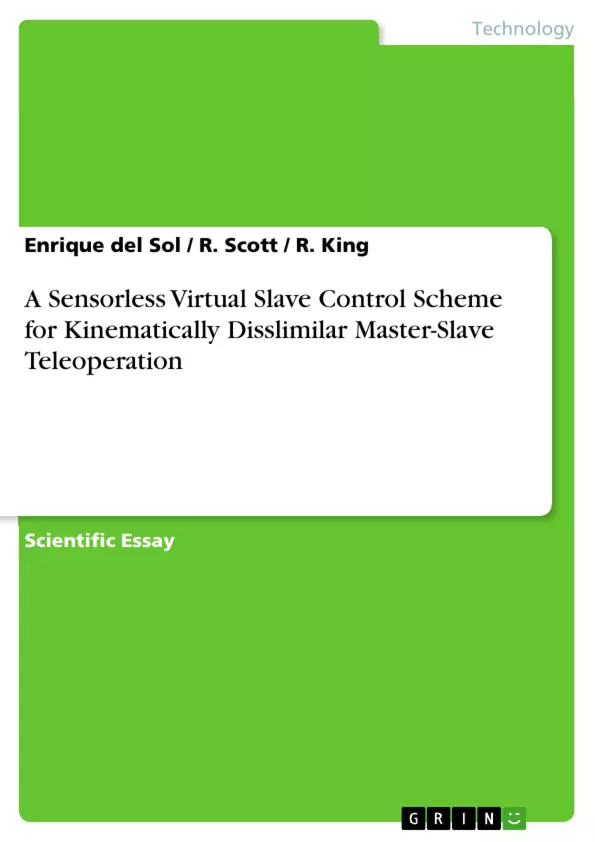This paper is organised as follows: section 2 summarises the remote handling issues in the design of control rooms for teleoperating dissimilar master-slave bilateral systems, section 3 covers the radiation tolerance of robotics systems with special attention to force sensors, in section 4 the sensorless virtual slave architecture is explained and the theory behind the sensorless force feedback is discussed.
Section 5 details the experimental equipment used in this research while in section 6 we present the results obtained in 1 degree of freedom.
Finally in 7 we present the conclusions and future applications of this technique in multiple degrees of freedom.
The use of telerobotic systems is essential for remote handling (RH) operations in radioactive areas of scientific facilities that generate high doses of radiation.
Recent developments in remote handling technology has seen a great deal of effort being directed towards the design of modular remote handling control rooms equipped with a standard master arm which will be used to separately control a range of different slave devices.
This application thus requires a kinematically dissimilar master-slave control scheme. In order to avoid drag and other effects such as friction or other non-linear and unmodelled slave arm effects of the common position-position architecture in nonbackdrivable slaves, this research has implemented a force position control scheme.
End-effector force is derived from motor torque values which, to avoid the use of radiation intolerant and costly sensing devices, are inferred from motor current measurement. This has been demonstrated on a 1-DOF test-rig with a permanent magnet synchronous motor teleoperated by a Sensable Phantom Omni® haptic master. This has been shown to allow accurate control while realistically conveying dynamic force information back to the operator.
Inhaltsverzeichnis (Table of Contents)
- Abstract
- Introduction
- Remote handling control rooms
- Radiation tolerance of telerobotic systems
- Force sensor for robots and radiation performance
- Sensorless force feedback approach
Zielsetzung und Themenschwerpunkte (Objectives and Key Themes)
This paper aims to explore a sensorless virtual slave control scheme for kinematically dissimilar master-slave teleoperation, specifically focusing on applications in remote handling (RH) for radioactive environments. The research addresses the challenges of radiation tolerance in robotic systems, particularly the limitations of force sensors. The objective is to develop a cost-effective and radiation-hardened approach for teleoperation that can be used with a variety of slave devices.
- Radiation tolerance in telerobotic systems
- Limitations of force sensors in radioactive environments
- Sensorless force feedback approach for teleoperation
- Kinematically dissimilar master-slave control
- Application of the sensorless virtual slave scheme in remote handling
Zusammenfassung der Kapitel (Chapter Summaries)
- Abstract: Introduces the paper's topic, highlighting the need for telerobotic systems in remote handling operations, the challenges of kinematically dissimilar master-slave control, and the proposed solution of a sensorless force-position control scheme.
- Introduction: Provides background information on remote handling applications in various scientific facilities, emphasizing the need for human intervention in complex and hazardous environments. It discusses the history and evolution of teleoperation systems, highlighting the challenges of non-backdrivable robots and the potential for using haptic masters for control.
- Remote handling control rooms: Describes the design and development of a standard work cell for remote handling tasks at ITER, highlighting the human factors and iterative design process. It explains the need for flexible control systems to handle various slave devices, including kinematically dissimilar ones.
- Radiation tolerance of telerobotic systems: Discusses the impact of radiation on human beings, focusing on deterministic and stochastic effects. It examines the radiation levels in various facilities, including CERN and ITER, emphasizing the need for radiation-hardened robotic components. The section specifically explores the limitations of force sensors in radioactive environments and the need for alternative solutions.
- Sensorless force feedback approach: Presents the sensorless force feedback approach as a solution for achieving force-position control in radioactive environments. It explains the advantages of this approach over traditional force sensing methods, particularly in terms of cost and radiation tolerance. The section emphasizes the use of a virtual slave model with approximate dynamics to estimate end-effector forces without physical sensors.
Schlüsselwörter (Keywords)
Telerobotic systems, remote handling, sensorless force feedback, kinematically dissimilar master-slave control, radiation tolerance, virtual slave, haptic master, ITER, robotics, force sensors, teleoperation.
- Quote paper
- Enrique del Sol (Author), R. Scott (Author), R. King (Author), 2012, A Sensorless Virtual Slave Control Scheme for Kinematically Disslimilar Master-Slave Teleoperation, Munich, GRIN Verlag, https://www.grin.com/document/308190



